By Jean English
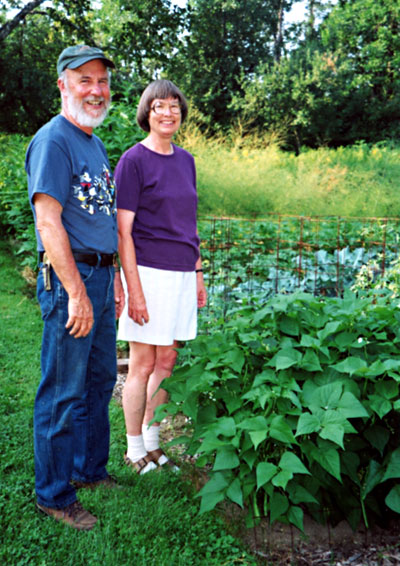 |
| Mike and Margie Shannon are happier living off-the-grid in Knox and raising most of their vegetables than they’ve been any other place they’ve lived. Jean English photos. |
Margie Shannon’s father would approve of the life that his daughter and son-in-law, Mike Shannon, have built on the north side of Frye Mountain, at 1000-feet elevation, in Knox. The solar-, wind- and propane-fueled house, the productive garden, and the water conservation measures would meet his standards, and the fuel-efficient Honda Civic hybrid in the driveway would amaze him.
“My dad was hyper about water and water conservation,” says Margie. Working for the Soil Conservation Service, “he laid out contour strips all over New York state … He didn’t like drainage ditches. I remember my dad giving me a lesson on hand washing as a little kid. He said, ‘Turn the water on, dampen your hands, turn the water off. Soap up. Turn the water on just a little bit … ’”
Today, when Margie brings potatoes or carrots in from the garden, “I put a little pan in the sink, scrub them in that, take that water and throw it out on the lawn or something. It’s just so much habit. There’s no reason to [conserve]; we have this wonderful well.”
“But,” Mike says, completing Margie’s thought, “water is a precious commodity.”
“It’s just like being off-grid,” adds Margie. “It’s the idea of being conscious of these gifts that you have.”
Their lifestyle has been a conscious evolution. It began on a “semi-farm” in New York for Margie, where she attended a “tiny little country school.” Mike was born in St. Louis. His father worked for Shell Oil, so during the war the family was transferred to Texas, then near New York City, where Mike finished public schooling. Both graduated from Springfield College in Massachusetts, where they studied outdoor education. In fact, that’s where they “were matched,” Margie explains. “The first night I was at college, my roommate [from Calais, Maine] said, ‘Hey, I’ll help you find a boyfriend!’ She starts going through her list of friends’ names, she’s going ‘No, No, No … ,’ then, ‘Mike Shannon, he’s just the one for you!’ We’ve been together ever since, celebrated 43 years.”
After college they lived on wildlife sanctuaries in Ohio and Massachusetts, always in the public eye, as Mike worked as a naturalist/educator with groups such as the Audubon Society. They had two children, now grown.
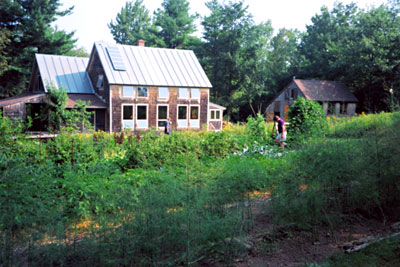 |
| Energy from the sun is captured in a front-yard garden and in six solar panels atop the roof of the Shannon’s house, which also benefits from passive solar heating. |
In 1990, Mike was laid off from his job in Massachusetts when the Audubon Society was in a financial hole. He and Margie had wanted to move to Maine, but “we found ourselves up here earlier than we had planned, and we didn’t know what to do,” he says. “Margie didn’t have a job, I didn’t have a job, so we were kind of hanging by our thumbs for a while. Margie was able to find a job as a Chapter 1 teacher at Mount View High School.” She is still there, now teaching “an incredible program – Spire – to kids who never learned how to read, and it’s working!”
Mike had nothing to do for a year, then got involved with the SAD 3 schools and, through them, met the chair of the environmental program at Unity College. “The phone rang one afternoon,” says Mike. “He was looking for faculty to teach ornithology. I said, ‘Sure, let’s do it,’ and it will be 10 years this spring.” He’s taught ornithology and seven other classes as an adjunct faculty member at Unity.
Finding their house was fortuitous. After much searching, they read an editorial by Pam Bell (former editor of The MOF&G) telling why she and her husband were moving to Waldo County. The Shannons, MOFGA members even then, found that Pam’s reasons for moving to the area matched their goals. They contacted real estate agent Peg Worth of Belfast, told her what they were looking for, and she said, “That’s interesting. Do you know Pam Bell? You and she are looking for the same place.” Worth took them to two places, a farm in Swanville (which Bell ended up buying), and a place in Knox. “I had told Margie earlier,” says Mike, “when it’s the right place, it will tell us. We got out of the car, we looked at each other, we looked at this place. It was just the right place.” They are still excited to be in a location with a “wonderful support network. I think we’re happier here than we’ve ever been anywhere. We’re involved in this WOG [Waldo Organic Growers] group, and MOFGA is just a stone’s throw away … We pinch ourselves now and then to make sure it’s real!”
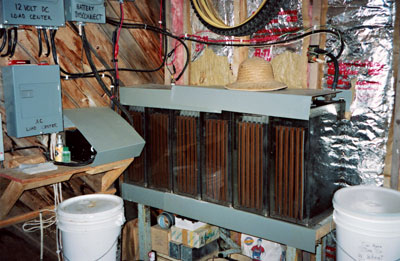 |
| A bank of batteries stores the charge from the windmill and solar panels. |
An Efficient House
Their house, with its open floor plan and single bedroom upstairs, is just right for two people. It was built in 1980 by Chris and Dennis Harrington, with help from community members. The old beams in the ceiling, some tamarack, some hand-hewn, came from five old barns in the area. Mike and Margie bought the house in 1987 and named it Ravens’ Place.
Six 3-foot-wide Kyocera solar panels on the roof, each 50 watts, create a 300-watt array, and a 400 watt AIR 403 wind generator, purchased from the Green Store in Belfast, complements the solar panels. Electricity from the panels and wind generator comes through a Heliotrope 60 amp charge controller, which prevents overcharging the lead-calcium battery bank and prevents the stored charge from leaking back to the panels at night. The electricity is stored in six 2-volt cells, so the house has a 12-volt system. The house has both AC and DC wiring. In case of excess wind, which could destroy the wind generator, a shut-off switch is in place. “The wind generator doesn’t work much in the summer,” says Mike, “because the leaves on the trees stop a lot of wind.” The wind generator, heavy duty pole on which it’s mounted, and cable for bringing electricity to the house cost about $1200 two years ago.
They also have a Winco 1800 rpm propane generator that powers their stove, refrigerator, freezer, vacuum, water pump, water heater, washing machine, iron and a little heater that they rarely use. Every third day they turn on the generator to pump a fresh supply of water into a 165-gallon holding tank. Filling the 500-gallon propane tank in the back yard is the only utility bill they have, other than the telephone bill.
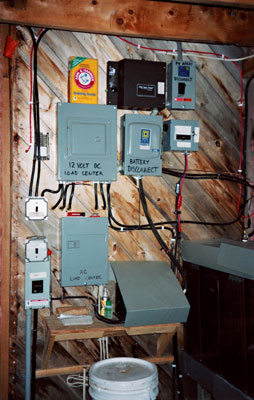 |
| The control center for the wind- and solar-derived energy. |
Relying primarily on wind and solar makes the Shannons “very aware of day and night,” says Margie. “We’re much more engaged in living in this house than anywhere else we’ve lived,” Mike adds, “because we’re up, always looking to see what today’s weather is going to be, to see if it’s going to be cloudy for a week. If that’s the case, we tend to husband the electricity we have. We can store 840 amp-hours of electricity in these batteries.” On a sunny day, the PV panels produce 1 kwh. The wind generator produces an equivalent amount on a windy day or night.
“But you shouldn’t use more than 10% of the power [in the batteries], because it’s not good for the batteries,” Margie continues. “So that means you can still use 85 amp-hours, and in a day we seldom go over twenty-five. Of course, we go to bed early.”
The batteries originally came from the Morrill Telephone Company and have been in the house for over 20 years. The only maintenance involves monitoring their sulfuric acid level. A large box of baking soda sits nearby in case of an acid spill. “We put these little hydrocaps on,” Mike explains. “When these batteries are charging, they’re off-gassing, but the caps recycle that gas. And we have a small trace inverter, which takes the direct current stored in the batteries and converts it to AC. So we have a regular color TV and a computer and a few AC lamp loads. See the red light flashing?” he asks, pointing to a tiny light on the wall. “That means we have no AC on. If an AC load is on in the house, the red light stays on and hums.”
Inside the house, a dial on the wall “tells us more than we know how to understand,” says Margie. “It says the battery is 100% full. This says that at the moment the battery registers at 12.9 volts. Usually at night it says 12.2. Amps says we’re making 121/2 amps. We made a list of how much power different things use. There’s a DC water pump that takes quite a lot. The kitchen lamp over the sink takes 1.7 amps; the light in the pantry (an incandescent light) takes 2.5; the stained glass lamp takes 3; the TV takes 4. We bought an IMac and ran it for 20 minutes and it sucked up a whole day’s worth of electricity!” They returned it, then “got a laptop, and that doesn’t use as much as the TV. The printer uses a lot, but you don’t have to use that much.”
“In a house like this,” says Mike, “you have to stay away from things that have heating elements, like toasters, hair dryers, any resistance heating, because it draws an enormous amount of power. If I run the slide projector or the vacuum cleaner,” says Mike, “we run the generator. The inverter [a Trace 612 SB modified sine-wave inverter with battery charger] will handle most of the small things. We could have gotten a larger inverter, which would have handled the vacuum cleaner and the washing machine.”
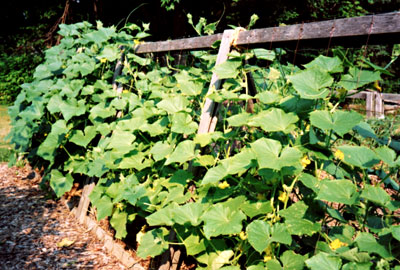 |
| A-frame trellises with tomato wire strung across to support vine crops. The 4×8 trellises are used elsewhere in the garden with the 8-foot length upward to support beans. |
The propane refrigerator, with its “wonderful big freezer,” sits in a utility room off the kitchen. One wall of the room is lined with shelves of produce Margie has canned. Nearby is a little Maytag washer that the Shannons bought from MOFGA member Jack Kertesz. “It has a little washer thing,” says Margie, “that spins around on the side, just rotates the clothes, takes very little soap, but you can’t put much [laundry] in. You divide your laundry into about eight little loads. Then a little spin basket gets them practically dry. It takes about 40 minutes to do a whole laundry, but it’s fun – fun for people who like to play in the water.” Margie carries pails of water from the faucet in the kitchen to do the laundry.
When the Shannons first moved to their home, the generator and water pump were hooked into the electrical system together, so when the generator started, so did the 220 water pump. They changed that, so the two are independent now.
Being off the grid makes the Shannons “very thoughtful of the things we’re using,” says Margie. “You don’t turn things on and leave them on, unless you’re there. If everybody lived that way, they’d have low electric bills. We have a friend who decided she was going to put solar panels on and so she replaced her refrigerator that had been her grandmother’s with a new, modern, energy-efficient refrigerator, and replaced her light bulbs with energy-efficient light bulbs, and her monthly bill went down $40 just by doing that!”
“Our house is open one day every October for the National Solar Energy Tour,” Mike continues. “People with teens ask, ‘Can we live this way?’”
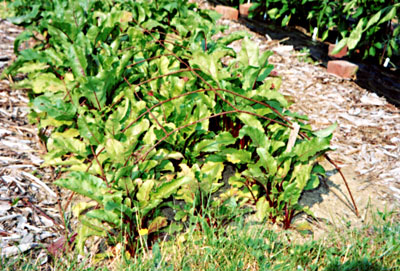 |
| The Shannons use concrete reinforcing wire (Rebar) throughout the garden, to deter deer, support plants and hold row covers. Here beets thrive under a low tunnel of Rebar that was covered with a row cover earlier in the season. A wood chip mulch keeps weeds down in the paths between permanent growing beds. |
“Six large panels isn’t much,” Margie interjects, “although Jack Kertesz, I think he’s got one panel!”
“You could spend lots of money and live like you would normally live, and do it with alternative energy,” says Mike, “but that seems to defeat the purpose.”
Their house is heated with wood, and their new, double pane, energy conserving windows help retain that heat.
Gardening
“As a child we were always growing things,” says Margie – including bees. “My dad was a beekeeper and had a lot of bees. When I was in college he would periodically send me a letter with an envelope inside, and it said, ‘This is the location of my apiaries. Open it if something happens to me.’ – because my mother got upset if he had more than 100 colonies of bees. So I know he had a lot more than one hundred.”
“He got 12 tons of honey one year,” says Mike.
“He loved bees,” Margie continues. “He always had bees in the back yard, and he’d take a chair and go out and sit and just watch them.”
Her father’s love of nature has carried over in Margie’s love of gardening, as reflected in the 2800 square feet of perfectly neat permanent beds of vegetables, all separated by permanent paths mulched with wood chips. The garden is even edged, thanks to Mike.
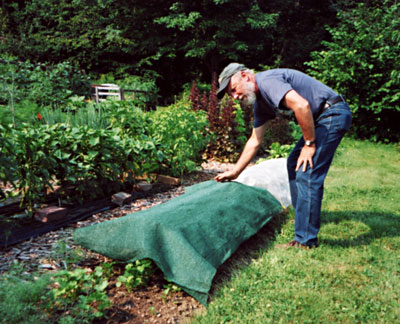 |
| Mike shows how Rebar tunnels can be covered with a frost-protective row covering (white, in background) or a cooling shade cloth. |
The couple has fabricated various structures to support and cover their plants. They buy concrete reinforcing wire (Rebar) and bend it to make low, hoop-like structures that they can cover with plastic, Reemay or shade cloth, depending on the crop and the season. The covering material is held on with clothes pins. They use the same structures, without coverings, to support beans and to keep deer from nibbling plants. Beans supported by Rebar don’t flop over, so are cleaner and don’t seem to mildew so much. “If the hoops are low, the beans get up above them,” explains Margie, and picking the beans is easy. If they’re too tall, Mike and Margie have to reach through the spaces in the wire, and picking is much harder.
They also make tomato cages from Rebar, leaving spiky ends on the tall ones so that they can stick them in the ground. Tall cages, for indeterminate tomato varieties, are about 51/2-feet tall, and the Shannons set two tomato plants where each cage will go. Determinate varieties grow in cages that are 21/2 feet tall. If the plants do grow out of these shorter cages, another cage is stacked atop the bottom one and held on with clothes pins. They dig the planting holes with a post-hole digger and put in manure, rock phosphate, azomite, greensand and soil. “I think azomite makes a big difference,” says Margie. They used to add rabbit manure, too, but no longer raise rabbits. They produce enough tomatoes for fresh consumption and to put up about 30 quarts each year.
Their cucumber bed produces enough to make about 35 quarts of dill pickles. “I pick them when they’re just 6 or 7 inches,” says Margie, “just enough to snip the ends off and fit them in the jars.” The vines are supported on wooden A-frames across which “tomato wire” is stretched. This is a thinner wire than Rebar, but the spaces are still large enough for hands to reach through. The 4- x 8-foot frames are tied together with rope at the top. Squashes and pole beans are grown on A-frames too, but the frames are turned so that the taller dimension is up.
 |
| Tomatoes are grown in cages made from Rebar. The square openings are large enough to reach through and pick tomatoes. |
The Shannons were still harvesting peas in mid-August. In fact, they had just picked 12 pounds of peas and 5 pounds of beans on the same day. “They say never build on a north slope,” says Mike, “but it stays moist here.”
A Reliance peach tree near one corner of the garden suffered in 1998, when the ice storm killed half of it, but this year, the Shannons harvested more peaches than ever. They grow blueberries under the tree, but may move them and mulch around the tree with cardboard, because poison ivy is growing among the blueberries. Margie suspects that lime may kill the weed, too. “Poison ivy occurs with blueberries, so it may like acid soil,” she reasons.
A small, lush bed of flax grows at the top corner of the garden. “I’m determined, within my lifetime, I’m going to learn how to process flax,” says Margie. “I’ve grown it [before]. I got seed a year ago from Johnny’s and planted a little plot like this and saved a little bunch like that. This year it was not in the catalog, but they had some that hadn’t been tested for germination, so they couldn’t sell it. So they gave me an ounce of seed.” This is “line flax” for spinning. “You have to ret the fibers,” says Margie, “and that’s what I can’t do. I overdo it, and it just falls apart. I just have to go and learn someplace.” The plants are grown 1/2-inch apart in all directions to make them tall and thin. Margie scatters the seed and covers it with a little soil, then puts Reemay on top of it until it germinates. It produces “beautiful little blue flowers, just gorgeous. If we have a long season, I’ve got to get the seed, because I can’t count on wheedling any more out of Johnny’s.”
In this size garden – part of which is fairly shady – rotation isn’t always possible, and the Shannons like to grow their potatoes in the same low-pH spot each year anyhow. They add pine needles and other organic matter to keep the soil acidic and minimize scab disease. “Last year we got 350 pounds of potatoes from about 100 row feet,” says Margie. “We still have potatoes from last year.” They mulch them with straw from Shartners’ [a nearby fruit farm], who get it from the St. John River Valley in New Brunswick, where oats aren’t sprayed. “It’s a lot more expensive than hay, but it’s just so pretty and it lasts a couple of years.”
All of their beds are covered with straw in the winter, as well as with leaves and grass collected by their mulching mower. “Sometimes we do a little prep of the beds in the spring; other times we just scratch the surface and plant,” says Margie. The straw (instead of hay) and absence of horse manure have helped minimize weeds in the garden. The wood chips in the paths also “made a big difference,” says Mike. He gets them behind the maintenance buildings on Congress Street in Belfast.
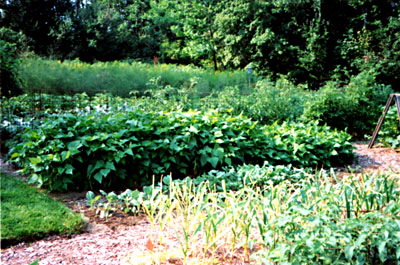 |
| The beans in the left half of the row are supported by Rebar, keeping plants of the ground and, thus, cleaner and less susceptible to disease. Plants on the right are growing without Rebar. |
Margie tends two kinds of Jerusalem artichokes in another corner of the garden. “Most years I put in 16 little stakes [where individual artichokes sprout], and I thin them to one sprout per stake. That keeps the numbers down, so the artichokes are big. We eat them in soup and in stews. They give it kind of a smoky flavor. The flowers smell like sweet chocolate – more like Nestle’s than Hershey’s,” says Margie.
Margie sows “all different kinds of dry beans, pretty ones” together, including some large red kidney beans that she bought at the grocery store years ago. “I make bean salad with dark beans and light beans together. I just plant them all in together, and then it’s fun when you shell them out.”
The Shannons water their garden from rain barrels in front of and behind the house. The barrels in front of the house are actually liners for wooden barrel planters. “I found this one that has this little [spout] at Agway,” says Mike. When water almost tops that barrel, it overflows into an adjacent barrel. Watering cans are easily dipped into the wide barrels. The barrels behind the house held handwashing soap, delivered to Unity College.
This year Mike and Margie also experimented with milk jugs set into the garden, with a few holes poked in the bottom. The jugs were filled with water, which slowly seeped deep into the soil. Other recyclables – quart yogurt containers – provide labels for rows of vegetables.
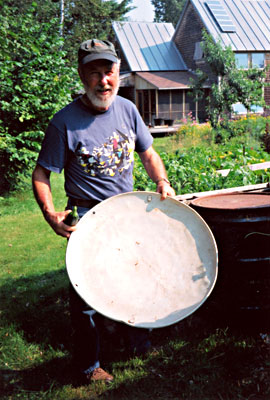 |
| An old “flying saucer” covers the compost barrels, when it isn’t being used to collect weeds and transport them to the compost. |
Compost
Like all good gardeners, the Shannons compost their vegetable scraps and spent plants. They store household waste in bottomless barrels in the garden until they have enough material to fill their wooden compost bin, then “we mix it all up,” says Mike. The holding barrel is covered with a “flying saucer” sled, which also “makes a great thing for weeding,” adds Mike. “Just pull it along. It makes a great weed bucket.”
Putting Up Produce
Much of the produce from the garden is canned. More goes into the freezer in the unheated room attached to the house. Margie is pleased with the neat little, stackable, reusable cardboard freezer boxes that she got from a hardware store in Belfast. “I’m so frugal, they’re going to last me the rest of my life,” she jokes.
Large plastic storage bins with covers, purchased from Marden’s, sit on shelves in the unheated room, still holding potatoes that grew in the garden the previous summer. Margie finds Elbas and Kennebecs in two boxes. “Oh, Lord, there’s more potatoes,” she exclaims, opening boxes of Carolas and Red Norlands, neither of which has sprouted yet.
Additional staples are purchased at Uncle Dean’s Organic Grocery on Memorial Drive in Waterville. “You can buy all this stuff in bulk,” says Margie, at prices lower than those of some co-ops. “It’s all packaged up. Raisins – organic for $1.35 a pound; Bulgur, 92 cents a pound. And it’s fresh. We’ve never had any bug problems. We buy beans in 25-pound bags.” This pantry sometimes drops to 32 or 33 degrees in winter. “If it gets colder, we bring these potatoes or other sensitive things into the kitchen overnight, or leave the door open a little and the heat from the house helps.” The heat from the freezer helps a little, but not much when the temperature is near freezing.
Favorite Tools
Mike and Margie have a small collection of favorite tools, some that Margie has had since she was a child working in the family garden; some purchased from Liberty Tool Company; some from yard sales and some custom-made. They are especially enthusiastic about their broad fork. “A friend at the college had one he bought … for 120-odd bucks,” says Mike. “I took it to Doak’s [Machine Shop in Belfast]. [Patrick Stevens] looked it over and asked, ‘What is it? It looks like some sort of a torture instrument.’ He said he was sure he could make one and charged me $60 to make this. Then I went to the Peevee Manufacturing Company in Eddington, which makes peevees for logging. They said, ‘What is that thing?’ They made two 4-foot handles, ash, it cost me less than $5 for the handles.”
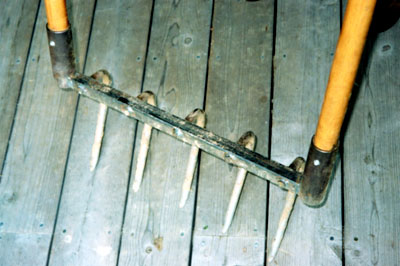 |
| A broad fork that was custom-made in Belfast is one of the Shannons’ favorite tools. |
Some broad forks have straight tines, but the Shannons say that the comma-shaped tines provide much better leverage, based on research that Eliot Coleman did and on their own experience. Patrick Stevens even reinforces the tines – unlike forks from mail order companies. “I just think the world of this tool,” says Mike. “It’s a joy to use,” adds Margie. “Just move backwards with it. It’s very gentle and it doesn’t thresh the earthworms to pieces … ” “ … once you get permanent beds made,” Mike says. “You can’t break new ground with it,” Margie agrees. Mike has asked Stevens to make several broad forks for friends over the years. The most recent one cost $84, including the handles.
A potato fork is used to rake beds, remove straw and loosen soil. A “great little hoe,” with the handle in line with the point so that you can eye right down the row, is used for making furrows. “We look for tools with small diameter handles,” says Margie. “A lot of tools have these great big, heavy handles. You’re not supposed to work hard and beat things to death!”
Green Transportation
Rounding out their conscientious lifestyle, the Shannons bought a Honda Civic gas-electric hybrid car last summer to take advantage of its 55 mpg highway rating. “It’s just a plain Honda Civic except that it’s got this electric motor in it,” says Margie. “It charges the battery, which is behind the back seat, off the motor and off the brake. People – even though they know we live off grid! – say to us, ‘How often do you have to plug it in?’ There’s nothing we’ve found that’s wrong with this car. It holds five people, and it’s just perfect.”
Sharing Their Lifestyle
Their house may be smaller than many, but the Shannons don’t hesitate to open it to groups. In addition to the Solar Tour, Mike brings his college classes: “I think it’s important for them to see not only me out of the role of being a faculty member but just as a human being, and for them to meet my wife and to have good food together and to see another way of living.” They also host the Waldo Organic Growers each year and have “a big winter solstice meeting.” Once, when Mike was supposed to lead 40 people on a tour of Moosehorn, rain interfered and he brought them to his home instead. “They were thrilled to death to see another way of living, another lifestyle, and for us to just throw the house open. They were amazed that my wife would let 40 people come into this house on a rainy day!” Even large groups can be accommodated by the solar/wind/propane system. “I bring my college classes over here for an evening meal,” says Mike, “and we have lights on all over the house, and we’re flushing toilets.”
Typical Yield Figures
Data from 1999 provide typical yield figures for the Shannons’ garden, which produces nearly all of the vegetables that they eat all year.
| First Harvest | Pounds Harvested | |
| Asparagus | 5/17 | 25 |
| Rhubarb | 6/14 | 10+ |
| Spinach | 6/19 | 18 |
| Peas | 7/7 | 23 |
| Broccoli | 7/11 | 18 |
| Chard | 7/14 | 18 |
| Carrots | 7/17 | 94 |
| Snow Peas | 7/22 | 3+ |
| Beans (Green, Yellow, Purple) | 7/22 | 32 |
| Yellow Squash | 7/23 | 20+ |
| Zucchini – Costata | 7/23 | 34+ |
| Sugar Snap Peas | 7/29 | 3+ |
| Beet Greens | 8/6 | 2 |
| Red and Green Cabbage | 9/14 | 35 |
| Garlic | 7/31 | 13 |
| Beets | 18 | |
| Winter Squash | 30 | |
| Eggplant | 3 | |
| Cucumber | 7/29 | 101 |
| Tomatoes | 7/31 to 8/28 | 232 |
| Peppers | 31 | |
| Onions | 85 | |
| Potatoes | 260 | |
| Leeks | 19 | |
| Parsnips | 14 | |
| Total | 1141 |
Some Favorite Varieties
Beans – Nor’easter pole beans are flat and “really good”; also Provider beans, and Indy Gold (yellow) beans from Johnny’s, which are juicy.
Beets – Cylindra (formerly called Formonova)
Carrots – “Bolero! Last year out of two beds we got 75 pounds of carrots. We had carrots that were so big!”
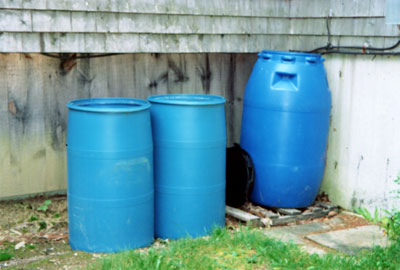 |
| Rain barrels collect water from the roof. |
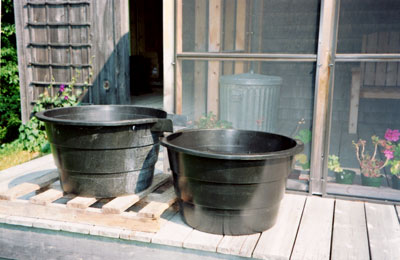 |
Cucumber – Marketmore
Kale – Red Russian, Lancelot and Conserva
Lettuce – Red Sails
Onions – Mars (red onions); Copra; Ailsa Craig, which usually produces bulbs that are a pound and a quarter or even heavier; Candy
Pak choi – Joy choi has nice, thick leaves
Peach – Reliance
Peas – Green Arrow “always seem to do well.”
Peppers – Toreno; Hungarian Hot Wax; Banana
Potatoes – Kennebec is number 1; others include Red Norland (early), Red Cloud (late), Elba (early), Cobblers, and Carolas.
Pumpkins – Long Pie
Spinach – Tyee
Tomatoes – They get San Marzano plants from local grower Claudette Beaudry; other favorites are Sweet 100s, Sungold, Jet Star and Bell Star. The latter has replaced a Heinz variety of paste tomato that they used to grow that “always died of some disease. Bell Stars hang right in there, really produce well, and can beautifully. They’re not as juicy, you’re not left with 2 inches of liquid in the bottom of the canning jar.”
Zucchini – Raven, from Johnny’s, is “gorgeous; doesn’t get huge; real dark green and real smooth.” They also grow Costata striped zucchini.

